Peter MALONE
Army of Thieves, The
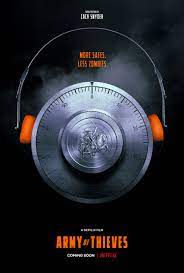
ARMY OF THIEVES
US/Germany, 2021, 127 minutes, Colour.
Matthias Schweighofer, Nathalie Emmanuel, Ruby O. Fee, Stuart Martin, Guz Khan, Jonathan Cohen.
Directed by Matthias Schweighofer.
With The Army of in the title, it is a quick reminder that this is a prequel to the zombie battle in Las Vegas actioner, Army of the Dead. This prequel is a story of origins, focusing on the character of the safe cracker, Dieter Ludwig, the attention-drawing Mattias Schweighoffer, who had his moment of glory in breaking into the crack-defying safe, Gotterdammerung.
But, this time he is not only the central character of the action, it is very much his film. And, instead of originator, Zack Snyder, is also the director.
In many ways, this prequel is far more simple in its plotting than for Army of the Dead. It is basically Sebastian (Dieter Ludwig is only a game name), a fairly simple banker with an uneventful routine daily life in Germany, making a little video online and immediately being contacted, mysteriously, for an underground sports event. No, not martial arts. Safe cracking experts are assembled for a knockout competition, eager crowds betting. And, before you know it – and before he knows it – he is the champion and recruited again but this time for a larger, illegal venture.
We know this because Sebastian has told us a story at the opening of the film, about a genius safe maker who created four incredible safes and named them after Richard Wagner’s operas. But, sadly, the disillusioned inventor made a huge safe, went inside, locked himself in and died. The legacy is of the challenge to crack the Wagnerian safes.
Which is really what this film is about. Sebastian is recruited by a mysterious young woman, with a wealthy background, but wanting more excitement and having a flair for pickpocketing and thievery (Nathalie Emmanuel as Gwendoline). Also in the team are various nondescriptive experts, Korina (Ruby O.Fee) who was able to illicitly download Pirates of the Caribbean to when she was 12! Then there is Rolf (Guz Khan) the getaway driver who could take a guest limousine from the hotel, travel around town and have it back instantly on demand. Then there is Alexis, a weedy little boy who decides to body build and become a martial arts champion in superhero, admiring the films of Nicolas cage, and coming up with his pseudonym, Brad Cage!
The cracking of each of the safes is enjoyable, lots of editing and pace, slow, quick, ingenious getting into the various banks, Korina activating all kinds of doors and entries, Brad Cage having to intervene with Plan B, a masked diversionary robbery (mask: Richard Nixon), with the touch of violence, in love with Gwendoline but moved by some jealousy – even jettisoning poor Sebastian in the street who has to steal a pushbike and, instead of a car chase (well the car chases him) an extraordinary feat through Prague of bike riding.
In the background are the Interpol experts – though their leader, continually frustrated, could be a relative of Inspector Clouseau.
Those who want zombie action (and the film cleverly inserts anticipatory sequences from Army of the Dead as well as directly linking it in the final sequence) have complained about how slow it is. Maybe that is the European sensibility and pace. However, and this reviewer agrees, quite a number of people like the tongue-in-cheek irony of so much of the dialogue and the blending of Sebastian as an innocent abroad gradually taking more delight in his skills and notoriety, with heist conventions.
- The title, the focus on thieves, prequel to Army of the Dead? Scenes from this film incorporated? Sebastian’s nightmares and the zombies, and his cracking the Gotterdammerung safe?
- The European film, European tone and director, pacing, ironies? Locations, Paris, Prague, St Moritz? And the downbeat ending in Las Vegas? The musical score and style?
- The opening story, the inventor, his skills, the three safes, calling them after Wagner, the achievement in Gotterdammerung? His dismay, sealing himself in the safe, his death, the safe at the bottom of the sea? His heritage and challenge to cracking the safes?
- Sebastian telling the story like a fairytale? Making the video, explaining himself and his skills? Followers? His being recruited for the underground competition, the parallel with martial arts, betting, the crowds, the presiding, the safes, cracking the safes, Sebastian coming second, in the final, the champion and his anger, Sebastian waiting till the end, winning?
- The encounter with Gwendoline, the restaurant, spilling the coffee, the discussions, her pickpocketing, rousing his curiosity? The contrast with his routine, going to the bank, teller, his lunchbreak and sitting outside? Prospects?
- The explanation of the plan, to crack the safes? For the money, it also for fulfilling a quest? The challenge? Korina and her skill with technology, the story of downloading movies illegally? Rolf, the cars, his skill in driving? Alexis, weedy, exercise, muscles, superhero, martial arts, Nicolas Cage films, Brad Cage? The relationship with Gwendoline? The plan to recruit Sebastian and then jettison him?
- The portrayal of the safe cracking scenes, the different cities and their background, the technological skills, getting into the banks, Gwendoline and the safe deposit, letting Sebastian in, the challenge, playing Wagner music, opening the safes? Each safe more difficult? Prague, Interpol observing, the dangers, Gwendolyn fighting the guards, Brad Cage and Plan B, the masked robbery, Richard Nixon, the doubts and not killing anyone, the final escape, pulling Gwendoline into the van, Brad letting Sebastian fall on the street, his running, stealing the bike, the chase, his adventures on the bike, on the back of the train, meeting Gwendoline and Korina again?
- The third challenge, St Moritz? Interpol, staking out the bank, the previous mess in Prague? The leader, vengeance, mistakes, Beatrix as his assistant? The discovery that the safes had already been removed? Korina pretending to be Interpol, the arranging of the safe to be transferred, in the truck? Sebastian and the tumble of the truck, eventually unlocking the safe? Brad and Rolf, surveillance, pursuit? Holding up the truck, Gwendoline turning the tables? The arrival of Interpol?
- The final confrontation, at the boat, the head of Interpol, the guns, Gwendoline urging Sebastian to escape, his finding the passports, going to the US, setting up his shop and calling it after Gwendoline?
- The visit from the cast of Army of the Dead and the invitation to Sebastian to crack the Gotterdammerung?
Did you know this: episcopal ordination of Alain de Boismenu took place in Sacred Coeur, Montmartre?
Did you know this: episcopal ordination of Alain de Boismenu took place in Sacred Coeur, Montmartre?

“On March 18, 1900, the basilica of Montmartre saw for the first time the ceremony of an episcopal ordination. The new bishop is not yet thirty years old, he is the youngest in Christendom. For forty-five years he will be the much loved pastor of the Papua New Guinea mission.

It is Monsignor Alain de Boismenu, missionary of the Sacred Heart, called by Paul Claudel "the bishop with a lion's heart" to salute the intrepidity of the faith in this giant of the missionary apostolate. “
On the occasion of his anniversary, November 5th, a note that he was ordained bishop in the basilica, Sacre Coeur, Montmartre, 18th March 1900.
He received his episcopal consecration in Paris at the Basilica of Montmartre on 18 March 1900 from the apostolic nuncio Benedetto Lorenzelli with Alexandre-Louis-Victor-Aimé le Roy and Louis Couppé serving as the principal co-consecrators. (Wikipedia).
There is a report that there is an image of Our Lady of the Sacred Heart in the basilica. Can any of our visitors confirm this?
And a reminder, from the lengthy entry in Wikipedia.

Alain Marie Guynot de Boismenu (27 December 1870 – 5 November 1953) was a French Roman Catholic prelate who served as the Vicar Apostolic of Papua from 1908 until his retirement in 1945; he was a professed member of the Missionaries of the Sacred Heart and the founder of the Handmaids of the Lord. He studied under the De La Salle Brothers before beginning his religious formation in Belgium where he did his studies for the priesthood. He served for a brief period as a teacher before being sent in 1897 to Papua New Guinea to aid in the missions there; he also served the ailing apostolic vicar and was soon after made his coadjutor with the right of succession. His stewardship of the apostolic vicariate saw the number of missions and catechists increase and his tenure also saw the establishment of new schools and a training center for catechists. s
The beatification process for the late bishop launched in 1984 and he became titled as a Servant of God. He later became titled as Venerable in 2014 after Pope Francis confirmed he lived a life of heroic virtue.

Palazzo di Cozzo
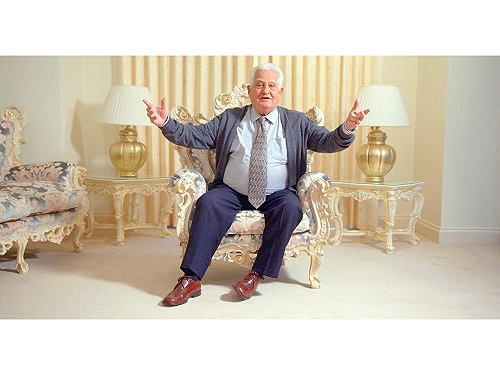
PALAZZO DI COZZO
Australia, 2021, 85 minutes, Colour.
Directed by Madaleine Martiniello.
Franco Cozzo is a Melbourne icon, a self-made man, seller of furniture over many decades, furniture in the baroque style. Clearly, this is a film for Melbourne, for Melbournites who are not as young as they used to be and who remember the flamboyant salesman from his television commercials. They may have forgotten a lot of the detail, but this documentary will revive the memories.
But, Palazzo Di Cozzo is not a documentary simply for the inhabitants of Melbourne. It is extremely relevant for Australians. And it offers much of interest to international audiences.
The reason for saying this is that Franco Cozzo’s story is almost an archetypal migrant story, from any culture to any other culture, difficult beginnings, determination and enterprise, success. And, since so many migrants came from Italy to Australia (as they formerly did to the United States), this is the study of the meaning of migration, the implications for what it was for the migrants to adapt to their new country.
While Franco Cozzo, 83 at the time of making the film, 85 at the time of its release, is certainly at the centre, self-promotion was definitely his forte, enjoyably so for himself and for the public, there are also quite a number of talking heads discussing the immigration issues.
There are photos and footage from the past. And the filmmakers have been very diligent in finding a great deal of film material from the 40s and 50s illustrating the arrival of migrants, their initial jobs, community support… And, this kind of footage is very creatively used in a significant part of the film where one of Cozzo’s sons goes to prison for drug dealing and word goes round, suspicious of Cozzo himself and involvement in drugs. There is a visual collage, extensive, illustrating whispering, gossip, suspicions, accusations.
But, Franco Cozzo himself has sailed through life, marriage and children, separation and divorce, second marriage and children, an extraordinary success in business. In fact, the film includes visits to several homes, visual tours of houses to look at the furniture in situ.
But, we all, this reviewer included, remember the commercials. And they are repeated here – though initially he seems to be able to pronounce Footscray accurately enough but as time went on, there was the inserted that vowel sound (this reviewer remembering it as Foot-a-scray), seen on screen now many times as Footisgrai. Franco Cozzo so relished the Ads in Italian, even extending some of them into Greek. And there was the continual reminder, genially urgent, “Grand Sale”. And there he was on television shows, being interviewed by Don Lane and dramatising his sales pitch, his daughter appearing on Young Talent Time and a callout from Johnny Young, newsreaders to giving stories about him, like Mike Willesee.
So, while there is plenty of footage from the past, there is also plenty of footage of the man himself aged 80, still full of life, contemplating selling his Footisgrai store, discussions with agents, his changing his mind, reviewing all the furniture that is still there and probably unsellable (although there are some sequences with incoming Asian and African potential clients).
So, Australia has been called the lucky country – and, for Franco, for this migrant from Sicily, bringing out his parents, starting from scratch, Australia was lucky (but we must never underestimate Franco Cozzo and his business shrewdness, ingenuity, boundless energy).
Void, The
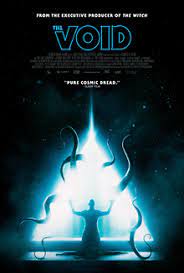
THE VOID
Canada, 2016, 90 minutes, colour.
Aaron Poole, Kenneth Welsh, Daniel Fathers, Kathleen Munroe, Ellen Wong, Mik Byskov, Art Hindle, Stephanie Belding.
Directed by Jeremy Gillespie, Stephen Kostanksi.
A Canadian horror film produced with crowdfunding, starring veteran Canadian actors Kenneth Welsh and Art Hindle.
This is the kind of horror film that devotees really like, the type of film that is shown in special festivals, Monster Fest, Underground Horror… (Where, in fact, it has won some wards.)
There is certainly a mysterious opening, a man and woman fleeing a house, an older man and a younger man firing at them, setting the woman alight, the man struggling to the highway where he is found by the local police officer and taken to the hospital.
Once within the hospital, most of the characters are trapped, although the father and son invade the hospital, threatening the man found by the wayside. But, there is a glimpse of a hooded person and then the revelation that outside the hospital there is a whole host of similarly hooded people, menacing.
The mystery deepens within the hospital, the roadside victim becoming more manic, the appearance of the woman who was burnt, peeling off her face, the local doctor attacked and slashed, a young woman there to give birth, attended by her grandfather, and the nurse in charge, the sheriff’s estranged wife, still grieving because they lost a child.
Quite a set up then for interactions, violent outbursts.
The sheriff then decides to go with the mysterious father and son down into the basement of the hospital, which leads to further basements, and the site of mysterious rituals where a cult figure, the local doctor, urges people to sacrifice themselves so that they can be with him in the cult.
Along the way, there are various exciting episodes, the sheriff and the two men trying to rescue a rifle from the sheriff’s van, and a nervous nurse having to assist with the birth of the child but unable to help with a caesarean, various violent outbursts and shooting.
One for the monster Fest fans.
Ron's Gone Wrong
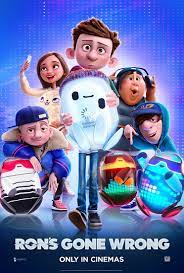
RON’S GONE WRONG
UK/US, 2021, 104 minutes, Colour.
Voices of: Jack Dylan Grazer, Zach Galifianiakis, Ed Helms, Olivia Colman, Rob Delaney, Justice Smith, Kylie Cantrell, Ricardo Hurtado, Ruby Wax.
Directed by Sarah Smith, Jean-Philippe Vine, Octavio E.Rodriguez.
Ron’s Gone Wrong is the first animation feature from the British studios, Locksmith Animation. But, the setting is, it would seem, California. The voice talent, quite varied, is both British and American, with Jack Dylan Grazer (the 2 It films) as the central young character, Barney, and comedian Zach Galifianakis as the entertaining voice of the rather crazy at times robot, B*Bot, Ron. And it is a surprise to find that Olivia Coleman voiced the rather strong-minded plump Polish grandmother.
This is an animated entertainment for a 2020s audience, youngsters who are at home with all kinds of technology, in a US where every child has its own personal AI B*Bot, (visually akin in some ways to R2D2). They come in assorted colours and personalities, friends, playthings, companions at school, in games. So, that is the kind of technical world we will come to expect.
But the story is of Barney, his widowed father who makes rather useless novelty toys, his dominant grandmother. Barney wants his own robot and father and grandmother find one that has fallen off the back of a truck and bring him home to the delighted Barney. But, he does not work properly, which leads to all kinds of jokes, mistakes, even some riots at school.
In the meantime, there is Mark, the young creator of the B*Bots (African-American, voiced by Justice Smith) and the dastardly, profit-criminally ambitious to be CEO, Andrew (Rob Delaney), who continually reminds us how unscrupulous and greedy big business is (or can be). Which means then that Ron has to be recalled, crushed, but rescued by Barney and taken into the woods, and then an excursion into the enormity of the Cloud, to rectify Ron’s workings.
There are also a number of children from the school, once Barney’s friends, now either ignoring or bullying him. We can see where this is going towards a happy ending.
For adults watching this film, it offers a lot of time to think about our technological age, the growing dependence of everyone, and now children, on their own robots, on their own AI. Which may teach them a lot about relationships and companionship. But, the question lurks, why is it that the film is showing us how youngsters relate better to robots than they do to one another, the film belatedly urging some friendliness between the children themselves, but more on the with the robots. Already, children spend so much time in front of their screens. While the robots might get them out of the house, it is still a technological dependence rather than developing human relationships. While that may not have been the intention of the filmmakers, the question is do emerge.
The creator is called Mark, echoes of Mr Zuckerberg – and, was it in the filmmakers intentions to have Andrew, the profit-engineering CEO, to be the business after ego of Mark Zuckerberg? A thought!
- The film for young children, especially boys, but for adults?
- British animation, British and American voices, the California setting, the Californian way of life, technology, big business?
- The style of animation, the visuals, the characters, the robots and their colours and characters, the adults, home, town, school, the woods? The plant, the crusher, the Cloud? The musical score?
- Barney’s story, age, mother died, father and his work with the novelties, trying to make money, the dominant Polish grandmother? His birthday, wanting his own robot, his father going out to find one, the refusal of the store, the robot which fell off the truck, bring it home? Barney’s joy?
- The robot, a companion for children,? To learn friendship?
- Ron and his name, calling Barney Absalom, getting details mixed up, gesticulating on his face, mouth, nose, eyebrows? His voice? Friendship with Barney, the accidents, knocked over by the car, at school, the other robots, Rich and the bullying, the girls and their ignoring him, the science girl and her help?
- Mark as the inventor, young, enthusiastic, the algorithms? Andrew, business only, profit-only? Shrewd with the staff, lying, discovering Barney and Ron in the woods? Humiliating Mark? Taking over as CEO?
- Barney, desperate with Ron, going into the woods, their adventures, their fears? Coming back?
- Ron, the threat of the crusher, Barney rescuing him? The meeting with Mark, the discussions? Saving Ron from the crusher? Having to go into the Cloud? The vastness, checking the data?
- Andrew, being exposed, moving off, Mark taking over?
- School, Barney and Ron, training him, the background of all the notes on the wall about friendship, Ron wanting only to see him as a friend rather than just his being a friend to Barney?
- The reconciliation with the girls, with Rich and the other boys?
- Themes of friendship, the highlighting of friendship with robots, the need for human relationships and friendship amongst the children?
Last Duel, The

THE LAST DUEL
UK/US, 2021, 152 minutes, Colour.
Matt Damon, Adam Driver, Jody Comer, Harriet Walter, Ben Affleck, Alex Lawther, Martin Cokas, Nathanial Parker, Zeljko Ivanek.
Directed by Ridley Scott.
The first film in Ridley Scott’s distinguished career (from Alien to Thelma and Louise to Gladiator and so many more films) was The Duelists. He began with a story of rivalries, honour, slights, vengeance, duels. And, almost 45 years later, he has gone back to these themes.
The film opens in 1386, France, during the Hundred Years War. The crowds are assembled, the rival Lords are putting on their battle dress, the duel is announced. But then, the screenplay (written by Matt Damon and Ben Affleck, who had great Oscar success in 1997 with Good Will Hunting, and now working with Nicole Holfcener) goes into flashback, three chapters, the events seen from the point of view of the three central characters. (Some commentators have referred to Akira Kurosawa’s Rashomon with its telling of the same events from different perspectives, but, by and large, here everyone is agreed on the facts of what happened, despite the central offender in public denial – even though we see him going to confession and admitting his sin).
The action goes back 16 years, grim battle sequences, and the hero of this story, Jean de Carrouges (Matt Damon) being saved by the squire, Jacques Legris (Adam Driver). But, the audience is wary, because they have seen that Jean and Jacques part of the two protagonists of the duel. What has happened?
Jean is a strong and blunt man, financial difficulties, Jacques, now the tax collector for the local count, Pierre (and distracting Ben Affleck with blonde hair and goatee beard), a rather profligate man who welcomes Jacques into his household. In the meantime, Jean encounters the daughter of a Lord who had previously cited with the English but is now trying to reinstate himself. The daughter is Marguerite (Jodie Comer, Killing Eve, Free Guy). They marry – but, disappointingly, no children.
The central crisis is an attack by Jacques, presuming the affections of Marguerite, raping her.
This is told in the second chapter, the memories of Jacques. We see more of the background of his tax collecting, his being welcomed into the court of Pierre, discovering that he is a promiscuous man despite the initial dignified demeanour. And, the rape scene is brutal. He presumes that Marguerite has willingly participated and does not listen to her protests or felt her resistance. He does go to confession but the tendency is to give any benefits of doubt to the male, comment about the status of women as their husband’s property and so not a sexual issue. But, Jean, returning from battles in Scotland, listens to Marguerite, although he does tend to interpret the offence as challenging his own honour. There is a court case, Jean challenging Jacques to a duel.
Then it is time for the third chapter, Marguerite’s version of what happened, much the same except that we learn much about her strength of character and quality when her husband goes to war in Scotland and she successfully takes over the management of the farm. We see again her telling her husband, his reactions, her standing by her statements, the court case and her being badgered by the ecclesiastical prosecutor, the king (young, giddy, immature personality) deciding that the duel should go ahead.
As with the battle scenes, the long duel is visualised highlighting the brutality.
Many have noted that this is a mediaeval story but with 20th 21st-century themes, especially about the abuse of women, the automatic presumptions by the male offenders, more emerging court cases, exposes and punishment. (The scene where the body of Jacques is dragged along the ground and then strung up by the feet, naked, is a reminder of the dire consequences of a sort when the case comes to justice.)
- The opening, the setting up of the duel, preparations, dressing, the two protagonists, Marguerite? The assembly, the king, the protocols of chivalry? The first attack on the breaking of the lances? Then the flashback and the resumption of the duel at the end, grim, many broken lances, the men falling from their horses, the ground battle, knives, brutality? The reaction of the crowd, the giddy behaviour of the king, sympathises for Marguerite?
- The 1370s and 1380s? France, the hundred years war? Battles against the British? In Scotland? The variety of battle sequences, fierce, brutal, hand-to-hand?
- The location photography, the variety of French chateaux, the Castle in Tipperary…? Costume and decor, the style of the 14th century? Farm life and work? The aristocracy, wealth, taxes and demands, food, sexual license?
- The three chapters, the different points of view? The audience seeing clearly what happened?
- The issue of sexual assault, rape, the status of men, reasons and rationalisation, private confession, public denials? In the light of 21st-century surfacing of 21st-century consciousness of assaults on women? Men’s denials? Exposes, court cases?
- Jean de Carrouges and his story, status as a warrior, eventually being knighted, the tradition of his ancestors, his father’s death and his not being put in charge of his estate and the Fort? His life saved by Jacques? Their friendship, the issue of taxes, Jacques and his seeming friendship? Pierre as the Lord of the region? Cousin of the king? Jean and the encounter with Marguerite, his decision, the courtship, marriage? The priests blessing before the marriage night? His blunt and direct manner? His decision to sue Jacques, to sue Pierre? The consequences? Loss of favour, going to Scotland to war? At home, his wife’s dowry, the discussions, her father fighting on the side of the English and so suspect? The parcel of land, Pierre and its gift to Jacques? Jean and his being litigious, going to Paris to collect the 300 gold coins, his return, Marguerite and her telling him of the rape, his initial hesitation, his taking it personally about his honour, the decision to sue, the appeal to the king, his challenging Jacques to a duel, the court hearing?
- Jacques and his perspective, as a squire, in the wars, his saving Jean’s life? The bond? His friendship with Pierre, Pierre asking him to get accounts in order, collecting the taxes, the demands on Jean? His life at Pierre’s court, luxury, women? The years passing, the attraction to Marguerite, misinterpreting her, her looking at him from the window? His coming with the squire, gaining entry, the attack, his rationalisation, the brutality of the rape, his assumption about Marguerite’s response? The challenge, the hearing on the court, the prosecution of Marguerite, the king presiding, the decision about the duel?
- Marguerite and her story, with her father, shy, the issue of the dowry, the marriage, the religious ceremony, the prayer before the wedding night? Five years? Becoming pregnant? Jean’s mother and her continued presence, bitterness, taunts? Her friendship with Marie, Marie and her pregnancy? Looking at Jacques from the window – her reason, later disbelief and testimony against Marguerite? Her love for Jean, his absence in Scotland, her taking over the running of the farm, the issue of the horses and Jean and his brusqueness, Marguerite using the horses for ploughing the fields, the cattle, organising the house, getting the finances in order? The day of the rape, her perceptions of Jacques, the experience, her resistance, the aftermath? Jean’s response? Her standing by her word? The risk that she would be burnt alive if Jean died in the duel? Her pregnancy? The court hearings, the vicious prosecution and his questions? The decision for the duel, her dressing, standing in the box, her feet chained? Watching Jean? His victory, her being freed? The couple riding through the cheering crowds? A comment about the love for the child? The final images with the little trial trying to walk? Her watching?
- The presence of the clergy in the church, the wedding ceremony, the priests blessing the wedding night, Jacques and his going to confession and the priest giving him the benefit of the doubt, the church tribunal, the members, the issue of rape and women as property rather than sexual offence, the hearings, the interrogations?
- The French nobility, Marguerite’s father and his changing sides, Pierre, his lifestyle, friendship with Jacques, dismissing Jean, promiscuous, encouraging Jacques, relying on him for his management of the estate? The trial, the duel, his supporting Jacques, his disappointment?
- Jean’s mother, gaunt and witch-like, her dislike of Marguerite, her manner with her son? The day’s outing and taking the servants? The disapproval of Marguerite’s management? Marguerite challenging her, her own story of rape and living with it?
- An excursion into the later Middle Ages, wars and conquest, royalty and nobility, lifestyles, peasants and taxes, and the dramatisation of the issue of rape, the duel?
Halloween Kills
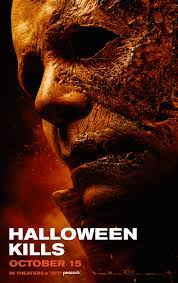
HALLOWEEN KILLS
US, 2021, 107 minutes, Colour.
Jamie Lee Curtis, Judy Greer, Andi Matichak, James Jude Courtenay, Will Patton, Thomas Mann, Jim Cummings, Robert Longstreet, Anthony Michael Hall.
Directed by David Gordon Green.
Heavens! (Or should that be Hell!?) It is 43 years since October 1978 when we reviewed the first Halloween film. Forty three years later, we have lost count of all the sequels and variations capitalising on sinister character, Michael Myers. So, here he is again, the same menacing threat, the same embodiment of evil, frequently referred to as the Bogeyman, not a suggestion of a redeeming feature, programmed to kill, programmed to kill in grisly, gory, cruel variations and close-ups.
David Gordon Green directed Halloween in 2018, focusing on the original central character, Laurie, Jamie Lee Curtis, her daughter, played by Judy Greer, her granddaughter, played by Andi Matichak. They thought they had destroyed Michael Myers by fire – and this episode takes up the theme from there, 2018, 40th anniversary of the first attacks by Michael Myers.
In fact, we don’t see all that much of Laurie, brought to hospital, rather cantankerous. In fact, the climax will be a confrontation between her daughter and granddaughter in the Myers house. But, on the way, there is a succession of characters, seemingly lining up to be brutally disposed of.
In the meantime, for those who don’t remember, there are some flashbacks to 1978, explaining how Michael Myers had killed his sister in 1963, had wrought mayhem in 1978 and had been institutionalised. (But, over the 40 years, he has managed to escape more times than we ever imagined.)
Perhaps the most distinctive aspect of this Halloween story is the mob mentality, out for vengeance, “evil is to die this night”. We are introduced to a number of people who remember the past, who remember confrontations, who are consumed with vindictiveness (led by Anthony Michael Hall, fiar different from his John Hughes comedy days, almost unrecognisable).
The key scene occurs when people take refuge in the local hospital, crammed together, fearful, roused by the leaders, chanting the slogan, setting their eyes on a poor old patient, assuming he is Michael Myers, pursuing him, shouting, forcing him to an upper storey ledge and his falling to his death. Ordinary people becoming mob-violent.
At the end, there is a voice-over commentary by Laurie herself explaining the nature of evil, how it cannot be extinguished, how it transfers from person to person. And, although David Gordon Green has notified that the next episode will be called Halloween Ends, the final image of Michael Myers seems to indicate – Halloween Forever.
Warrior Queen, The / of Jhansi
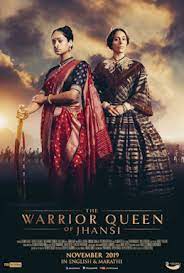
THE WARRIOR QUEEN
UK, 2019, 102 minutes, Colour.
Devika Bhise, Rupert Everett, Nathaniel Parker, Ben Lamb, R. Bhakti Klein,Omar Malik, Jodhi May, Derek Jacobi.
Directed by Swati Bhise.
In many ways, this looks like one of those popular adventures from the 1950s, the era when Cinemascope was introduced, leading to many widescreen action spectaculars. However, the theme of the film, the warrior Queen of Jhansi, who played such an important role in the Indian Mutiny of the 1850s, training and leading female soldiers, is much more 21st-century. So is the critique of the British Empire, the behaviour of the British in India over several centuries, the presumptuous colonial and superior attitudes, but, at this time, principally the exploitation of the East India Company.
Which means then that, while we appreciate the battle sequences, there are more themes to reflect on.
The title character is played by American actress, Devika Bhise, who is the daughter of the writer-Dir, Swati Bhise, an artistic entrepreneur. It is a hard role because in the early sequences showing her childhood in the court of Jhansi, tutored in arms by her father, then her marriage, death of her son, adoption of a view as the air, and growing up and training her female warriors, she is something of a strongly fierce figure. However, as the action goes on, her involvement in uprisings, battles, conflict with the British, defeats, she is a symbolic figure because of her rebellion but a tragic figure because of her defeats.
The production values of the film are quite high, especially the recreation of the courts of India and their culture in the 19th century.
There are sequences in Balmoral Castle where Prime Minister, Lord Palmerston,, comes to visit Queen Victoria (Jodie may), his exposure dating very superior attitudes about the British, about the archaic traditions of India, the need for “civilising” the people of the subcontinent. His played by Derek Jacobi. It is interesting that the screenplay includes the Indian Muslim advisor to her Majesty (taking up the theme of Victoria and Abdul, his presence 30 years after the present events).
And the British? They have occupied India for several centuries. The East India company, presided over by the greedy business and restored aristocracy of London, profit at all costs, have no sympathy, let alone empathy, for the Indians. Their representative, Hamilton, played with sinister relish by Nathanial Parker, present with the soldiers, scheming, using spies, contempt for the Indians. There are some sympathy in the character of the British commander, Sir Hugh Arose, played by Rupert Everett, who has some admiration for his opponents, a quotation from hitting in the final credits praising the Variety. There is also a sympathetic military translator, played by Ben Lamb.
Intentions for the film are very worthy. However, it plays as a reasonable, if fairly ordinary, Port of the times, the conflicts, the politics, the warfare, downfall of the East India company and, the reminder that, 90 years later, India achieved independence.
- The title? India, the 1850s, the heritage of British presence, the East India Company? Revolution? The Indian Mutiny of the 1850s? The leadership of the Rani?
- The settings, lavish, costumes and decor, the civilisation of the Indian kingdoms, contrast with the British military, presence, battles? The musical score?
- The structure of the film, the focus on the mutiny, the flashbacks to the childhood of the Rani, her voice-over and explanations, bond with her father, commoner, marrying, child, death of the child, adoption of the nephew, the continuity of rulers? Her becoming the Queen?
- The British situation, the issue of the Enfield rifles and the pork and beef fats, the revolt, murdering British officials? The reaction in London? The meeting of the East India company and its presumptions, hostility towards India, profit-Ames? Lord Palmerston, his visits to the Queen, his presumptions about Empire, the Queen and her hesitancy, a Muslim advisor and his presence, comments, Palmerston’s reactions? The Queen disturbed by the situation?
- The British military, the leadership of Sir Hugh Rose, his manner, beliefs, leadership, assessing the situation, strategies? The presence of Hamilton, Superior, vindictive, the Company? The presence of Ellis, his role as a translator, knowing and admiring the rani from the past, is delivering messages, advised to negotiate, failure to persuade the rani, Hamilton suspicious of his loyalties?
- The rani, preparations for war, the local kingdoms, siding with the British, changing stances, the bombardment of the walls of Jhansi, escape, the decoy and Hamilton’s misjudgment, the fights, British superior weaponry? The rest of the rani’s father, his execution?
- The final confrontation, the Rani having to flee – and her final comments about what happened to her, death, living on, reappearing in battles, a symbol of encouragement?
- The final information about her, about the British, the closing down of the East India Company, and the reminder that 90 years later India was independent.
Esteros/ Wetlands

ESTEROS/WETLANDS
Argentina, 2016, 86 minutes, Colour.
Ignacio Rogers, Esteban Masturini, Joaquin Parada, Blas Finardi Niz, Maria Merlino, Renata Calmon.
Directed by Papu Curotto.
Esteros/ Wetlands is a brief Argentinian film about sexual awakening in adolescence, separation for 10 years, a re-meeting and re-awakening. This is a gay theme.
The film shows two young boys who enjoy each other’s company, playing, horsing around, eventually realising a sexual attraction. However, one of the boys has to leave for Brazil where his father has taken a job and he studies a biology course there, returning after 10 years with his girlfriend. In preparation for a fancy dress party, he re-meets his old friend who is doing the make up.
As expected, this puts pressure on the young man who is a professional, interested in biology and the development of the wetlands. There are more flashbacks to their time as children, but most of the action takes place when the two of them revisit the wetlands, talking, re-living the past, having to shelter for rain and stay the night, the sexual re-awakening. Both are left with the consequences for the future.
- The title? Argentinian? The Wetlands? The visuals of the wetlands, homes, the waters, land? The background of the family homes in the past, the town, fancy dress party? The musical score?
- The introduction to Jeronimo and Matias, their age, friendship, sharing the pastimes, fooling around, wrestling, swimming, showers, and the mother taking so many photos? The flashbacks throughout the film, the first sexual encounter?
- Matias, his father’s job, going to Brazil, disappearing for 10 years, studies, returning, the girlfriend, preparing for the fancy dress party, zombies, his observing? His relationship with Rochi? His future with her?
- Jeronimo, staying in the town, house on the wetlands, his parents? Technician, special effects, make up? Gay, acknowledging this? His friends?
- Meeting again with Matias, talking, questions? The decision to visit the wetlands, the day there, reliving old experiences, sharing? Caught in the rain, staying the night? The sexual encounter? The consequences?
- Matias, returned to town, Rochi leaving, his staying, his work, with Jeronimo?
Sister of the Groom, The
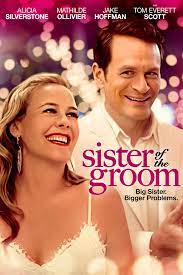
THE SISTER OF THE GROOM
US, 2020, 93 minutes, Colour.
Alicia Silverstone, Mathilde Ollivier, Jake Hoffman, Tom Everett Scott, Charlie Bewley, Mark Blum, Ronald Guttman.
Directed by Amy Miller Gross.
A wedding comedy, an elaborate Jewish wedding comedy, various functions in preparation, meals, Sabbath celebration, Jewish rituals, the wedding itself, the celebration.
Probably, enjoyment or not of this film will depend on your mood. It will also depend on response to the character, of the title, played by Alicia Silverstone. Initially engaging, perhaps, audiences remembering her past roles especially Clueless, but her losing some sympathy with her attitude towards the bride, protectiveness of her brother, the presence of her father, memories of her dead mother, memories of the house where the wedding is to be celebrated and the groom and his wife with their plans to tear it down and alter it.
Alicia Silverstone is Audrey, would-be architect initially, in love with another architect who has had a successful career and whom she meets at the wedding. She had an abortion when she was young. She is now married to Ethan (Tom Everett Scott, generally a genial screen presence and, for the most part, highly tolerant and understanding of Audrey until he bursts out). They have children in summer camp.
The action takes place over several days, introduction to the bride, French background, her mother and stepmother, her television comedy performer father, rather dominating, various musicians, various friends. The bride, Clemence, is played by Mathilde Ollivier, not initially sympathetic, singing, seeming to have plans about the house… And then there is Liam, Jake Hoffman, the happy then hapless groom.
The crowd which has come for the wedding seem to enjoy many of the celebrations, the meals, but with Audrey, there is growing tension, especially hearing about the alterations to the family home, to be designed by her former boyfriend, and she herself very concerned about the physiology of her stomach, very self-conscious – and then finding that her mother has left a $25,000 in her will for surgery (which her father, in fact, does not have).
One of the highlights is a screaming match on the part of Audrey attacking Clemence. There are further angry complications, overhearing news that Clemence has had an abortion and not told Liam, Audrey gossiping, undermining the relationship, even thinking that she had sabotaged the wedding. However, ever more complications, Audrey having to find address, her behaviour at the wedding party with the former boyfriend, Ethan and finding this an occasion for his blowing his top about their life.
However, the wedding goes ahead, the celebration, except that Audrey sprinkles drugs on one of the cakes and Clemence has a severe turn.
But, the screenwriter has decided that it is to be all’s well that ends well.
